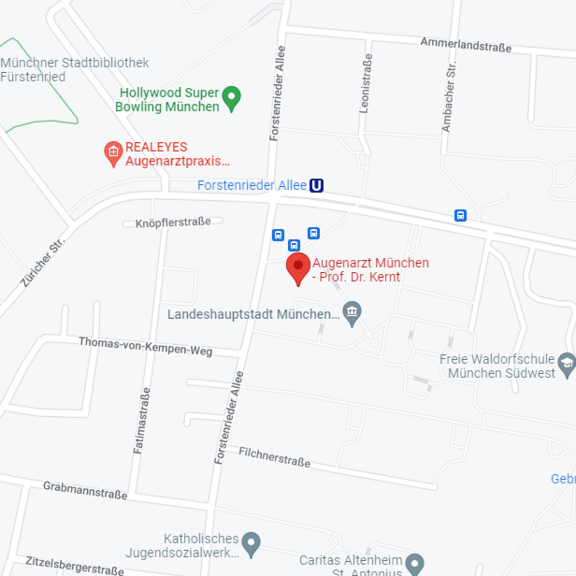Cataract - lens types
The surgical cataract treatment by Prof. Marcus Kernt involves removing the clouded lens and replacing it with an artificial lens (intraocular lens – IOL). Usually, this is a so-called monofocal lens, which then takes on the function of the natural lens. It has a good imaging quality, and in most cases it is able to correct general short- and long-sightedness. While the standard lens is not able to fully correct age-related vision loss or other visual defects, modern ophthalmology does offer a wide range of artificial lenses with special additional features that meet the individual needs of patients. These lenses with advanced optical functions are called premium intraocular lenses. It is very important to choose the right lens – after all, it will stay in the eye for ever and plays a significant role in the patient’s future vision. And so Prof. Kernt would like to take the opportunity and introduce the individual lens types in more detail on this page.
Here is a brief overview of the features of the different lens types:
Monofocal lenses
Standard lenses with UV protection filter; also available with UV protection filter for selected models;
- suitable for patients with general near-sightedness or far-sightedness;
- do not correct age-related long-sightedness or corneal curvatures;
- costs are fully covered by the health insurance companies
Multifocal lenses
Premium lens with several focal points;
- enables focused vision at various distances (reading, watching TV, driving);
- patients may no longer need to wear glasses most of the time
Aspheric lenses
Premium lenses
- correct a specific imaging error;
- improve contrast vision, especially in twilight, often combined with a UV and blue light filtering
Toric lenses
Premium lenses
- correct far and near-sightedness as well as corneal curvatures;
- generally means patients can watch TV and drive without glasses
Pseudo-accommodative lenses
Premium lenses
- designed to enable continuous focused vision at various distances;
- only fulfil this promise to an extent;
- not always recommended
"Yellow" blue light filtering lenses
Premium lenses with advanced filtering function;
- filter out short-wave radiation from the light spectrum;
- help protect the retina;
- particularly recommended for patients with damaged retina;
- available for all other lens types, as photochromic UV and blue light filtering IOLs that automatically adjust to lighting conditions.
Monofocal intraocular lenses (standard lenses)
These artificial lenses, which are the most commonly used in cataract surgery, have proven themselves millions of times and meet internationally recognised standards. In most cases, standard lenses are a very good substitute for the natural lens. They have a protective UV filter and usually provide high visual comfort. The costs for a standard lens are covered by the health insurance companies. Monofocal lenses have only one focal point and they work in the same way as single vision glasses, which correct either short- or long-sightedness. Because people typically get cataracts at a later age, many patients also have age-related long-sightedness. They may also have corneal curvatures, requiring the patient to wear glasses. These types of defective vision can often not be sufficiently corrected with a standard lens. Patients who opt for a monofocal lens will under certain circumstances and in certain situations require glasses. If they wish to be as independent of glasses as possible, it may make sense to consider a special lens with additional function, which will mean not having to wear glasses in many situations.
Premium intraocular lenses
These are special lenses with additional function that provide patients with enhanced visual comfort. Premium lenses meet the patient’s individual requirements and personal needs. They can correct special visual defects and they combine several functions. Certain premium lenses correct not only cataracts, but also many other forms of defective vision, making it unnecessary in most cases to wear glasses. For many patients this means a significant improvement in quality of life. The costs for the premium lenses are only partially covered by the health insurance companies. Private health insurance companies also do not always pay for the whole amount. Patients therefore usually have to pay a contribution to the cost of the premium lenses. It is our aim to restore your vision as much as possible. Before the procedure, Prof. Kernt will discuss with you in detail which special lens is suitable for you and which type of lens is to be considered for your eyes. Here, too, the basic principle is that the lens must suit your eye and meet your needs. Ultimately, it is up to you whether you opt for a premium lens. You take the time you need to make the right decision.
Multifocal intraocular lenses
Most older patients suffer from age-related long-sightedness. This may concern far vision as well as near vision – and quite often, people’s eyesight is more or less impaired for all distances. Normal standard lenses cannot fully correct these deficits. In this case, multifocal lenses can to a degree enable the patient to see clearly, both in the distance and nearby. They have several focal points, and in the best case they provide clear and focused vision for all distances, including watching TV, reading and looking into the distance. Depending on individual requirements, multifocal lenses can be bifocal or trifocal, which means they have two or three focal points. There are different acuity areas that map what you see to varying degrees of focus depending on the how the different focal points are arranged in the lens. In the best case, you no longer have to wear glasses with multifocal lenses. However, a multifocal lens can in many cases also significantly improve near vision; but this is often just a technical aid that cannot fully replace the continuous adaptability of the natural young lens. In the best case, the multifocal lens gives the patients better vision at certain intervals, including near vision; unfortunately, however, so far there is no continuous focus that varifocal glasses would provide. Nevertheless, these lenses often help patients with age-related long-sightedness to significantly improve their visual comfort.
Aspheric intraocular lenses
These special lenses can correct a specific imaging error – what’s called spherical aberration. This is an optical phenomenon that primarily impairs seeing contrasts and night vision. Aspheric lenses are very good at focusing the light and provide very good vision even in twilight and in the dark. This means that sufferers will see better even when light conditions are difficult and they can easily drive in twilight. Whether this type of lens is suitable also depends on the individual’s pupils size in the dark. This, as well as the degree of aberration, must be measured exactly before opting for an aspheric lens.
Toric intraocular lenses
Toric lenses are able to correct short- or long-sightedness as well as corneal curvatures (astigmatism). They are similar in effect to the lenses of glasses. Especially in cases where the corneal curvature is pronounced, toric lenses promise much better far vision. After surgery, patients can usually watch TV and drive without glasses.
Pseudo-accommodative intraocular lenses
These innovative lenses are designed to make images as focused as healthy young eyes do. Unlike with multifocal lenses, the incoming light is not distributed to several focal points. By creating the relevant curvature, the lens automatically focuses on the target when the eye moves. This is designed to create continuous vision for all distances. However, practice shows that the currently available models are not yet mature and only keep what they promise to an extent. Prof. Marcus Kernt therefore only recommends these lenses in specific cases.
"Yellow" blue light filtering lenses
These special lenses have innovative enhanced filtering functions. The light spectrum is composed of radiation from different wavelengths. Certain short-wave light in UV radiation is suspected to damage the fine nerve cells of the retina. These premium lenses specifically filter out this harmful radiation in the light spectrum. They make a significant contribution to protecting your retina and lower the risk of retinal diseases such as age-related macular degeneration. In studies, these slightly yellow blue light lenses also proved helpful for contrast vision in twilight. These premium lenses are available as monofocal and multifocal lenses, and as toric or aspheric lenses.
The so-called photochromic UV and blue light filtering IOLs are a very elegant special type of UV and blue light filtering lenses. With these artificial lenses, the protective filter automatically adjusts to individual light conditions as the lens changes its tint. This provides optimal protection for the eye in strong light without the need for permanently tinted lenses when light conditions are poor, which can potentially be a disadvantage.
Conclusion
All standard and premium lenses are of the highest quality and in keeping with the latest scientific findings. However, there are significant differences in the functions they offer the patient. Choosing your lens is about your visual quality of life. Prof. Kernt will be happy to assist you in choosing the right lens and provides comprehensive advice.
Contact
We are happy to advise you!
Prof. Dr. Marcus Kernt
Forstenrieder Allee 59
81476 München






